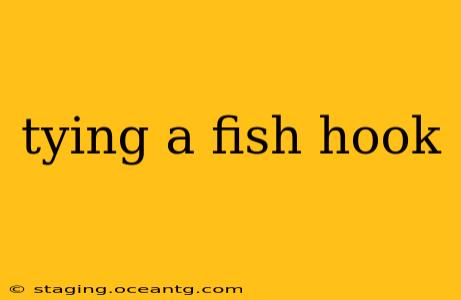Tying a fish hook correctly is fundamental to successful fishing. A poorly tied hook can lead to lost fish, frustrating experiences, and wasted time. This comprehensive guide will cover various methods, addressing common questions and concerns to ensure you’re ready to confidently tackle any fishing situation. Whether you’re a seasoned angler or just starting out, mastering these techniques will significantly improve your fishing game.
What Knots Are Best for Tying a Fish Hook?
Several knots excel at securing your line to a hook, each with its strengths and weaknesses. The most popular choices include:
- Improved Clinch Knot: This is the workhorse of fishing knots, known for its strength, reliability, and ease of tying. It's a great all-around choice for most fishing situations and line types.
- Palomar Knot: This knot is incredibly strong and easy to tie, even in low-light conditions. It's particularly favored for heavier lines and larger hooks.
- Uni Knot: A very strong and versatile knot, the Uni Knot is excellent for braided lines and fluorocarbon, minimizing line slippage.
The best knot for you will depend on the type of line you're using, the size of the hook, and the species of fish you're targeting. Experiment to find your preferred knot, paying close attention to its security and ease of tying.
How to Tie a Fish Hook with the Improved Clinch Knot (Step-by-Step)
The Improved Clinch Knot is a reliable choice for beginners and experts alike. Follow these steps carefully:
- Pass the line through the eye of the hook.
- Wrap the line around the hook shank (the curved part) five to seven times. More wraps are generally better for strength.
- Pass the tag end (the loose end of the line) through the loop formed next to the hook eye.
- Moisten the knot.
- Tighten the knot firmly by pulling on both the main line and the tag end simultaneously.
- Trim the excess tag end close to the knot.
Remember, practice makes perfect! Try tying this knot several times until you feel comfortable and confident in your technique.
How to Tie a Fish Hook with the Palomar Knot (Step-by-Step)
The Palomar Knot is known for its exceptional strength and simplicity:
- Double the line and pass it through the eye of the hook.
- Make a loop with the doubled line.
- Pass the hook through the loop, ensuring the hook point is pointing towards the loop.
- Hold the loop and the hook's eye, then carefully slide the knot down to the eye.
- Moisten the knot.
- Tighten the knot by pulling on the main line.
- Trim the excess tag end close to the knot.
What's the Easiest Knot to Tie a Fish Hook?
For sheer ease and speed, the Improved Clinch Knot and the Palomar Knot are both excellent contenders. The Palomar Knot might edge it out slightly for beginners due to its straightforward steps, but both are worth mastering.
How Do I Choose the Right Knot for My Fishing Line?
The best knot will vary depending on your line type:
- Monofilament: Improved Clinch Knot, Palomar Knot
- Fluorocarbon: Uni Knot, Improved Clinch Knot, Palomar Knot
- Braided Line: Uni Knot, Albright Knot (for joining different line types)
Always research specific recommendations for your chosen line to ensure optimal performance and strength.
What Happens if I Tie a Fish Hook Incorrectly?
An incorrectly tied hook can lead to several problems:
- Lost Fish: The hook can easily pull free from the line during a fight.
- Snagged Line: The knot can become tangled, hindering your cast and potentially breaking your line.
- Reduced Sensitivity: A bulky or insecure knot can reduce your ability to feel subtle bites.
Taking the time to learn and practice proper knot-tying is crucial for a successful fishing experience.
Conclusion
Mastering the art of tying a fish hook is a cornerstone of successful fishing. By understanding the different knots and their applications, and practicing regularly, you can significantly improve your fishing skills and enjoy more rewarding angling experiences. Remember, even experienced anglers continuously refine their knot-tying technique. So, grab your line and hooks, and start practicing!
